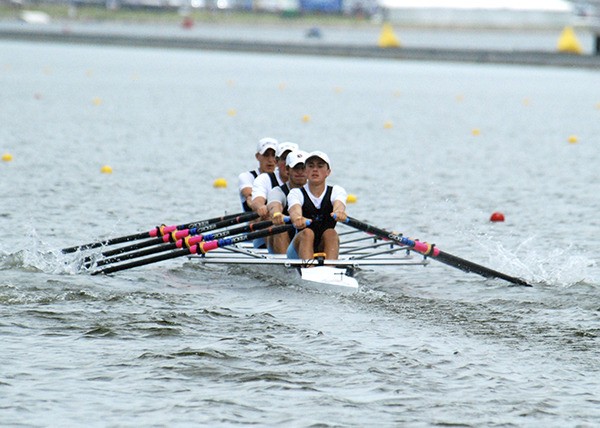By PAT CALL
For The Beachcomber
Most rowing venues on the annual crew calendar are rivers, lakes, estuaries or bays that have been temporarily set up as a racing course. Nathan Benderson Park near Sarasota, Florida, is a noteworthy exception, having been designed and constructed solely as a world-class rowing venue.
Nine lanes wide and evenly dredged, the racing course is flanked by a causeway that separates the course from the warm-up area, acts as a wave attenuator for crosswinds and allows golf carts to travel most of the length of the course to provide real-time video to spectators. This venue played host to the 2015 Junior National Rowing Championships, bringing crews from more than 160 clubs from across the country to compete in the steamy late spring of Florida’s Gulf Coast. The temperatures were hot, and the racing was hotter, with what many coaches observed was the most competitive Nationals in many years.
Vashon’s junior crew qualified eight boats for Nationals this year, but Coach Richard Parr chose to enter only five boats to avoid doubling up rowers in the challenging weather conditions with both temperatures and humidity in the 90s.
The regatta started with heats on Friday, where the winners moved on directly to Saturday afternoon’s semifinals, and the rest of the boats rowed again in the repechages, or reps, on Saturday morning. After the reps, 12 boats in each event advanced to the semis, six boats to Sunday’s C finals and the rest were out. Some events had 27 boats entered, so just making a final is an accomplishment.
Racing was proceeding smoothly on Friday, when precipitously at the conclusion of the Vashon women’s lightweight four heat, the sky turned black and the announcer forcefully ordered the racers off the water and the spectators into their cars. It was a true Auntie Em moment as boats started tumbling through the staging area, tents folded and twisted into intricate and improbable sculptures, lightning crackled menacingly and rain landed in horizontal sheets. Racing was suspended for the day, the schedule being as shredded as some of the tents. All of Vashon’s boats had completed their races by the time the storm hit, with one boat, the men’s quad, going directly to the semis and the other four scheduled for reps.
Saturday morning dawned cloudy and a little cooler with a westerly breeze. At the end of the reps, Vashon had three more boats to the semi-finals, and one boat, the lightweight women’s double, qualifying directly for Sunday’s C final.
In the afternoon semi-finals, the objective of every crew was to get a top-three finish, which would qualify the boat for the A final, or grand final, on Sunday. Bottom three finishers would go on to Sunday’s B final.
There was no repeat of Friday’s storm, and at the conclusion of the semis, the men’s quad had moved on to A final with a suspenseful second-place finish 0.02 seconds faster than the third-place boat from New Canaan, Connecticut. The women’s double, pair and lightweight four were all headed to the B finals.
Sunday’s finals made a solid statement about the increased competitiveness of junior rowing with numerous races having four to six boats finishing within a couple of seconds of each other and several finishers separated by less than one tenth of a second.
The men’s quad (Patrick Hanson, Fletcher Call, Liam McConnell and Forrest Miller) suffered a major malfunction know as “catching a crab,” where the oar dives at the end of the stroke and gets pinned to the side of the boat, often bringing it to a complete stop. The resulting force cracked the oar, which could have led to a race re-start if it had happened just 50 meters earlier. As it was, the quad did its best but was never in contention after that, finishing sixth in the nation.
The women’s pair (Riley Lynch and Rhea Enzian) and the lightweight four (Virginia Miller, Maddie McEachern, Shannon Lipe, Emily Milbrath and coxswain Ally Clevenger) both finished second in their B finals and thus eighth in the nation.
The women’s double (Kalie Heffernan and Kirsten Girard) finished their senior year and high school rowing careers with 12th place in the country.
The lightweight women’s double (KaiLi Scheer and Mabel Moses) took 17th in the nation with a strong race in the C final. Mabel celebrated her 14th birthday just before the regatta.
Summing up the weekend, a sunburned Parr congratulated the Vashon crew for strong performances and excellent rowing.
“On numerous occasions over the weekend, the announcers called out what I saw … that Vashon rowing was smooth, efficient and strong. You all should be proud of your achievement over this season and this weekend. You are great rowers, great students, great citizens and great ambassadors for Vashon Island.”
— Pat Call is a recreational rower and the father of a junior rower.



